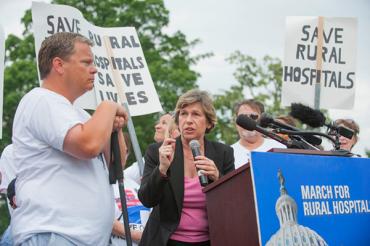In sickness and (for the wealthy) in health
President Trump is conducting his presidency like a reality TV show, with all the trappings. But in real life, Trump’s actions—his travel ban, now-debunked wiretapping claims and “skinny” budget proposal—have harmful consequences for our democracy and for people’s lives, including many of the people who voted for him.
Nowhere is that clearer than in healthcare. Trump’s rhetoric about healthcare is crashing up against reality. He promised to repeal the Affordable Care Act and replace it with a plan that would cost less and cover more people. He bragged there would be no cuts to Medicare or Medicaid during his presidency. And he tweeted that the Republican healthcare plan “will result in a beautiful picture.” But the bill released last week is a bleak betrayal of those promises.
The nonpartisan Congressional Budget Office found that under the American Health Care Act, drafted by House Speaker Paul Ryan with Trump’s strong support, 14 million people would lose health insurance by 2018 and 24 million would lose coverage this decade. Americans with the greatest needs would fare the worst under the AHCA. It would strip $880 billion in funding from Medicaid and eliminate $673 billion in tax credits that help low-income people afford health insurance. Healthcare expenses for many Americans would skyrocket—including a huge “age tax” on older Americans—and, in some cases, the cost of coverage could exceed a person’s annual income.
With so many losers under this bill, who wins? The wealthy, big time. Ryan and Trump are racing to repeal the taxes on the wealthy that, under the ACA, subsidized the cost of health insurance for those who couldn’t afford it. The GOP bill would lavish about $600 billion of tax cuts on the wealthy. The 400 richest Americans would get about $7 million each. In fact, the only tax their plan retains from the ACA is the mis-nicknamed “Cadillac tax”—a tax on middle-class Americans who obtain health insurance through their employers.
The harsh irony is that many who have benefited the most from the ACA—lower-income older people, in rural, Republican strongholds—gave Trump their vote and their trust yet stand to fare the worst under “Trumpcare.” A 40-year-old earning $30,000 in one of the counties that voted for Trump stands to lose more than $3,600 in tax credits under the GOP plan. A 64-year-old earning $27,000 per year pays $1,700 in premiums annually under “Obamacare.” Under Trumpcare, premiums would rise to $14,600 a year, a 750 percent increase.
The loss of Medicaid funds in the GOP bill would deal a devastating blow to the states that have expanded Medicaid coverage—like Ohio, where the Republican governor has spoken out against the GOP plan. It would be particularly harmful to the 40 million children who are eligible for Medicaid, including students with special needs who receive services in school. And the AHCA shifts $370 billion in Medicaid costs onto state governments, forcing them to choose between rationing healthcare and providing other vital services, like public safety, public education and public works.
The ACA needed to be fixed, like every piece of complex legislation. For instance, the AFT and others fought for a public option as a way to compete with insurance companies, for the ability to negotiate prescription drug costs, and to eliminate the tax on middle-class workers’ plans. Nevertheless, under the ACA, people with pre-existing conditions knew their coverage couldn’t be taken away, students knew they could stay on their parents’ health plans until age 26, and more than 20 million people without health insurance—who could be one illness away from destitution, or worse—gained access to healthcare.
The ACA should be improved, not eliminated. Lives literally depend on it. A new analysis estimates that, if the Republican health proposal becomes law, approximately 17,000 people could die in 2018 who otherwise would have lived. By 2026, the number of people who suffer preventable deaths could grow to 29,000 in that year alone. Those stark numbers represent real people—mothers, babies, breadwinners and best friends.
The “skinny” budget proposal Trump released this week is equally as hard-hearted and harmful as the GOP healthcare plan. It would wipe out 13.5 percent of the federal education budget alone—including after-school and summer programs that provide children living in poverty with a safe, enriching place to be and, sometimes, their only meal of the day.
Trump said he would be “president for all Americans.” But a shameful trend is emerging: tax cuts for the wealthy and service cuts for the needy. Reality is different from reality TV. And Trump’s actions as president are a far cry from his rhetoric feigning populism and concern for the needs of working families.

